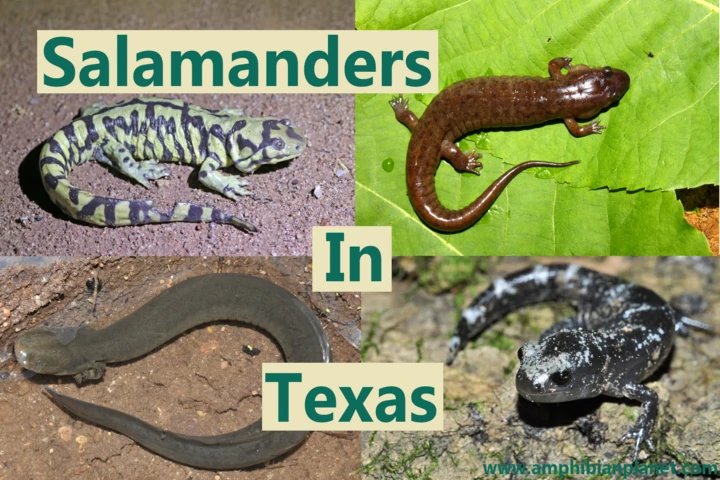If you live in Texas and love salamanders, you’re indeed fortunate because there are plenty of different salamander species in this region. In fact, there have been recordings of at least 28 different species of salamander in the state of Texas.
Most of these salamanders are terrestrial, which means they live on land. But there are also several fully aquatic salamander species.
These salamanders are silent, and spend most of the year hibernating, or hiding under rocks, logs, and other debris, so people rarely see them.
You are most likely to encounter one of these salamanders in the spring when they are most active.
Native Salamanders of Texas
As earlier mentioned, Texas is home to at least 28 species of salamander, some species more common than others. Since there are so many salamander species, the exact size and coloration vary between species.
If you ever spot a salamander in the state of Texas, It’s probably one of these. You can potentially see salamanders of any age or gender!
1. Marbled Salamander (Ambystoma Opacum)


| Average Adult Size (Length) | 3 – 5 inches |
| Average Lifespan (Years) | 8 – 10 |
Marbled salamanders are fairly small, only growing 3 to 5 inches in length from snout to tail.
These salamanders are dark gray to black with silvery crossbands running along with their chunky bodies. Because of this appearance, they are sometimes called “banded salamanders“.
Male marbled salamanders are typically smaller than females and have whitish crossbands that become very white in the breeding season.
In Texas, marbled salamanders can be found throughout the eastern part of the state from Red River south to the Gulf of Mexico.
Marbled Salamander Range. Map By: United States Geological Survey.

2. Eastern Tiger Salamander (Ambystoma Tigrinum Tigrinum)
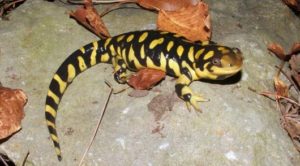
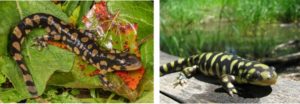
| Average Adult Size (Length) | 6 – 9 inches |
| Average Lifespan (Years) | 15 – 25 |
Eastern tiger salamanders typically range from 6 to 9 inches but can grow up to 13 inches, which makes them the largest terrestrial salamanders in Texas.
These salamanders can be easily identified by their dull brown coloration, with olive-yellow to brownish-yellow irregular blotches (“tiger stripes”), and a yellow underside.
Some eastern tiger salamanders may have brilliant golden yellow or light brown blotches, while others may be extremely dark with very little noticeable patterning.
In Texas, these salamanders can be found in the eastern part of the state.
Eastern Tiger Salamander Range. Map By: United States Geological Survey.
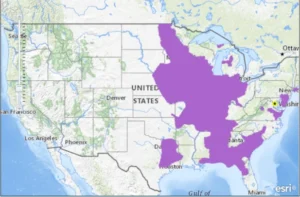
3. Barred Tiger Salamander (Ambystoma Mavortium)

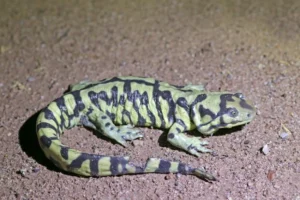
| Average Adult Size (Length) | 6 – 9 inches |
| Average Lifespan (Years) | 15 – 25 |
Barred tiger salamanders are sometimes called “western tiger salamanders”. As their name suggests, these salamanders are subspecies of tiger salamander and are very closely related to the Eastern tiger salamander.
Barred tiger salamanders grow 6 to 9 inches in length and have a gray, dark brown, or black coloration, with olive-yellow to brownish-yellow irregular bars and spots. The underside is yellow.
Since these salamanders look very similar to the eastern tiger salamander, the main way you can tell these two subspecies apart is by their coloration:
- Eastern tiger salamanders have lots of yellow spots or blotches on their body
- Western tiger salamanders have few yellow blotches, and the botches frequently form “bars”
Barred Tiger salamanders are distributed throughout Texas, except for the eastern part of the state.
Barred Tiger Salamander Range. Map By: United States Geological Survey.
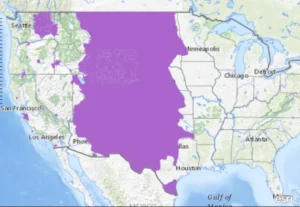
4. Smallmouth Salamander (Ambystoma Texanum)
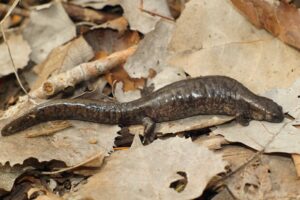
| Average Adult Size (Length) | 4.3 – 7 inches |
| Average Lifespan (Years) | 15 – 20 |
Smallmouth salamanders are sometimes called “Texas salamanders” or “narrow-mouthed salamanders”. They range between 4.3 and 7 inches in length and can be best identified by their small head with a blunt, short snouts. The head tends to appear swollen behind the eyes.
These salamanders have a brownish-gray to grayish-black coloration with light gray speckles of lichen-like blotches, particularly along the lower sides of the body. The underside is of the same color with little or no speckling.
In Texas, smallmouth salamanders are only found in the eastern part of the state.
Smallmouth Salamander Range. Map By: United States Geological Survey.
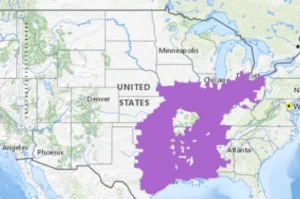
5. Spotted Salamander (Ambystoma Maculatum)


| Average Adult Size (Length) | 6 – 9 inches |
| Average Lifespan (Years) | 15 – 20 |
Spotted salamanders (sometimes called “yellow-spotted salamanders“) are fairly large, ranging from 6 to 9 inches long, with females typically larger than males.
These salamanders get their name from the two roles of yellow or orange spots speckled along their black backs and sides.
Some spotted salamanders have orange spots on the head, while the spots on the body are more yellow in color. The underside is pale gray with no spots.
These salamanders have broad heads and thick, heavy bodies with vertical grooves on each side of their body
In Texas, spotted salamanders are only found in the Northeastern part of the state.
Spotted Salamander Range. Map By: United States Geological Survey.

6. Mole Salamander (Ambystoma Talpoideum)

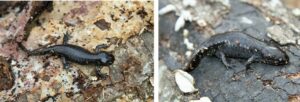
| Average Adult Size (Length) | 3 – 4 inches |
| Average Lifespan (Years) | 10 – 20 |
Mole salamanders are stout-bodied salamanders that grow 3 to 4 inches in length. They have short bodies and large, flattened heads that may look somewhat disproportional to the rest of their body.
These salamanders typically have a gray or dark brown coloration with pale bluish or silvery mottling and light gray undersides.
Mole salamanders can be found in the Gulf Coastal Plain of east Texas.
Mole Salamander Range. Map By: United States Geological Survey.

7. Southern Dusky Salamander (Desmognathus Auriculatus)
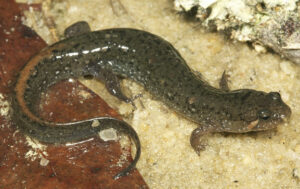
| Average Lifespan (Years) | 3 – 5 inches |
| Average Adult Size (Length) | 10 -15 |
Southern dusky salamanders (also known as “Holbrook’s southern dusky salamanders”) are fairly stout and grow between 3 to 5 inches in length.
Their coloration is highly variable, but they are generally dark brown to black with a row of white spots running down the sides of the body and tail. The underside is scattered with distinct white spots.
As in all dusky salamander species, a pale line runs diagonally from each eye to the base of the jaw, and their back legs are visibly larger than the front.
In Texas, Southern dusky salamanders can be found in the eastern part of the state as far as the Trinity River Basin.
Southern Dusky Salamander Range. Map By: United States Geological Survey.
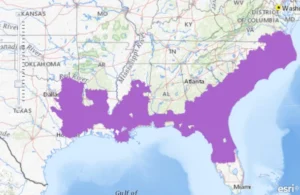
8. Spotted Dusky salamander (Desmognathus conanti)
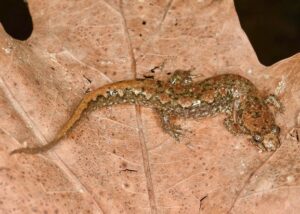
| Average Lifespan (Years) | 3 – 5 inches |
| Average Adult Size (Length) | 10 -15 |
As the name suggests, spotted dusky salamanders are a subspecies of dusky salamanders and are very closely related to the Southern Dusky.
Like the southern dusky, spotted dusky salamanders grow between 3 and 5 inches in length – and their back legs are noticeably larger than the front.
They have a variable coloration but are generally tan to brown to nearly black, with 6 to 8 pairs of golden or reddish dorsal spots, which are normally separated (hence the name “spotted dusky salamander”). In adults, these spots may form a light stripe with a dark, irregular border.
In Texas, spotted dusky salamanders can be found in the eastern part of the state and share much of their range with the southern dusky.
Spotted Dusky Salamander Range. Map By: United States Geological Survey.

9. Western Slimy Salamander (Plethodon Albagula)
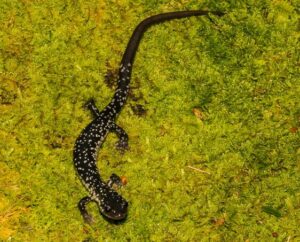
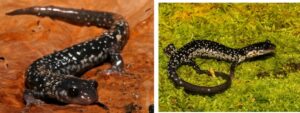
| Average Adult Size (Length) | 4 – 7 inches |
| Average Lifespan (Years) | 15 – 20 |
Western slimy Salamanders are fairly large salamanders reaching about 4 to 7 inches in length, with the tail about 70 percent as long as the body.
Like other slimy salamanders, this species has a black to bluish-black coloration with widely scattered white or brassy flecks.
This flecking pattern varies among individuals and may occasionally merge to create a white, highly mottled pattern along the sides of the body. The belly is typically colored a uniform black.
Slimy salamanders get their name from the very sticky mildly toxic goo they secrete when threatened. This goo sticks to the predator’s mouth enabling the salamander to escape.
Western slimy salamanders have isolated populations in south-central and extreme northeastern Texas.
Western Slimy Salamander Range. Map By: United States Geological Survey.

10. Southern Red-Backed Salamander (Plethodon Serratus)

| Average Adult Size (Length) | 2 – 5 inches |
| Average Lifespan (Years) | 15 – 20 |
Southern Red-backed salamanders have slender bodies and reach between 3 and 4 inches in length. They are typically gray or black in color – and despite their name, not all “red-backed ” salamanders have the color red on their backs.
They have many color variations but mainly have two variations: The red-back, and the lead- morph.
The red-back morph has a straight-edged reddish stripe (sometimes orange, yellow, or dark gray) running the length of its back from the base of the head to the tail, with dark sides. The lead-back morph, on the other hand, lacks the red stripe. It has a purely dark gray to black color on its back instead.
There also exists a morph where the whole body of the salamander is a pinkish red, sometimes with black spots.

In Texas, the natural range of these salamanders is poorly documented. It is thought that they occur in the extreme Northeastern portion of the state.
However, Southern red-backed salamanders in Texas are only known from a single specimen collected in Nacogdoches County in 1940.
Southern Red-Backed Salamander Range. Map By: United States Geological Survey.
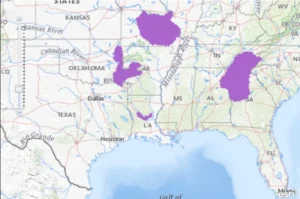
11. Dwarf Salamander (Eurycea Quadridigitata)

| Average Adult Size (Length) | 2 – 3.5 inches |
| Average Lifespan (Years) | Unknown, but estimated to be 5 – 10 |
True to the name, dwarf salamanders are one of the smallest salamanders in North America. Full-grown adults typically grow between 2 and 3.5 inches in length and may weigh less than a gram.
Dwarf salamanders typically have a yellow-brown coloration with darker brown blotching and dark stripes down each side.
These salamanders are unique, in that they only have four toes on each of their back feet, whereas most other salamanders have five toes on their back feet.
In Texas, dwarf salamanders can be found in the eastern parts of the state.
Dwarf Salamander Range. Map By: United States Geological Survey.

Newts in Texas
Salamanders are often informally divided into two groups: “Newts” and “true salamanders”.
True salamanders typically have smooth moist skin while newts tend to have more rough, grainy skin. In simple terms, newts are a specific type of salamander.
There are two types of newts that are native to the state of Texas.
12. Eastern Newt (Notophthalmus Viridescens)

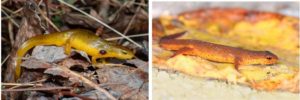
| Average Adult Size (Length) | 2 – 5 inches |
| Average Lifespan (Years) | 12 -15 |
Eastern newts grow between 2 and 5 inches in length and are one of the only two newt species found in Texas. Unlike most salamanders, many newts (including the eastern newt) have rough skin that is slightly moist, (just enough to keep it from drying out).
In the Juvenile eft stage (which lasts about 3 to 4 years), eastern newts have a bright orange-red coloration with a rounded tail.
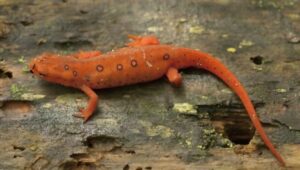
As adults, they generally have a yellowish-brown to greenish-brown coloration, with black-bordered red spots along their back; and a paddle-shaped, less rounded tail. The underside is yellow with small dark spots.
In Texas, eastern newts are found throughout the eastern part of the state – and are often found not very far from a water source.
Eastern Newt Range. Map By: United States Geological Survey.
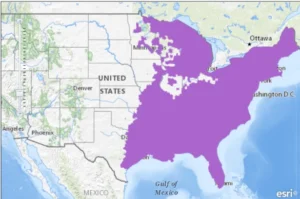
13. Black-Spotted Newt (Notophthalmus Meridionalis)
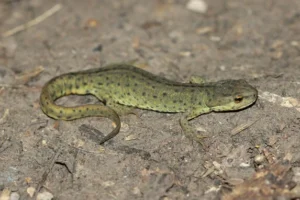

| Average Adult Size (Length) | 2.9 – 4.3 inches |
| Average Lifespan (Years) | Unknown, but estimated to be 12 -15 |
Black-spotted newts (Sometimes called, “Texas newts”) grow between 2.9 and 4.3 inches in length and look somewhat similar to eastern newts.
These newts typically have an olive green to silvery gray coloration, with numerous bold black and light-yellow spots. The underside of usually yellow in color, which sometimes extends up to the sides.
Like the eastern newt, black-spotted newts have paddle-shaped, vertically flattened tails to help them swim efficiently in the water.
Black-spotted newts can be found along the coastal plain of southern Texas from the San Antonio River to the Rio Grande. However, they are very rarely seen, partly due to their secretive nature.
Black-Spotted Newt Range. Map By: United States Geological Survey.

Aquatic Salamanders in Texas
Unlike terrestrial salamanders, aquatic salamanders live entirely in the water, even after transforming into adults. This means they have features that are adapted for life in the water, rather than on land.
Aquatic salamanders have more varied features than terrestrial salamanders. Some aquatic salamanders have 4 legs, but others only have forelegs and lack hind legs. Some have gills, but others do not and largely breathe underwater through their skin.
However, despite their varied features, all aquatic salamanders have flat paddle-like tails which they use to swim in their aquatic environments.
Here are aquatic salamanders found in the state of Texas:
14. Western Lesser Siren (Siren Intermedia Nettingi)

| Average Adult Size (Length) | 7 – 27 |
| Average Lifespan (Years) | 20 – 30 |
Western lesser sirens typically range from 7 to 27 inches in length. They have a gray to brown to nearly black coloration with a lighter belly. Individuals with lighter coloration often have small dark spots scattered on the head and back.
These salamanders have an eel-like appearance with a flat paddle-like tail. They have external feathery gills that resemble ostrich plumes, and two very small forelegs (they do not have hind legs). Each of the forelegs has 4 toes.
The name “lesser” comes from the fact that these sirens are typically smaller than greater sirens; lesser sirens are usually less than 2 feet in total length – in contrast, greater sirens frequently exceed 3 feet in total length.
Western lesser sirens can be found in slow-moving rivers, canals, and other calm water bodies – throughout the eastern and southeastern parts of Texas, as well as in the Rio Grande Valley.
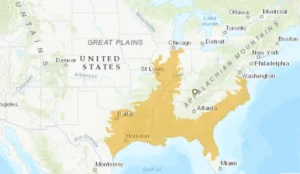
15. Rio Grande Lesser Siren (Siren Intermedia Texana)
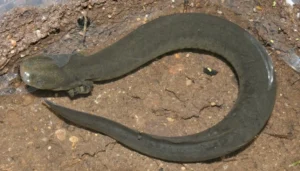
| Average Adult Size (Length) | 7 – 27 |
| Average Lifespan (Years) | 20 – 30 |
As the name suggests, Rio Grande lesser sirens are a subspecies of lesser siren and are very closely related to the western lesser siren.
In fact, scientists do not agree on whether the Rio Grande lesser siren is different from the western lesser siren.
Some researchers consider these sirens as just southern populations of the Western Lesser Siren. However, others consider them to be a different species.
Like the western lesser siren, Rio Grande lesser sirens typically range from 7 to 27 inches in length – and have a gray to brown to nearly black coloration with a lighter belly.
These salamanders can be found in south Texas in the lower Rio Grande valley.
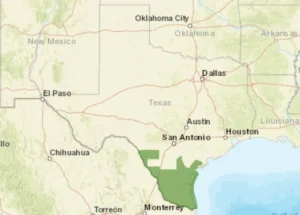
16. Three-Toed Amphiuma (Amphiuma Tridactylum)

| Average Adult Size (Length) | 18 – 30 inches |
| Average Lifespan (Years) | 15 – 20. |
Three-toed amphiumas are slender eel-like aquatic salamanders that typically grow between 18 and 30 inches in length.
They have four small inconspicuous vestigial legs, one pair just behind each side of the neck and another pair just ahead of the longitudinal anal slit.
However, they don’t use these to walk. When out of the water, they move in a snake-like pattern and use their legs as balancing organs. They get their name from the single toe on each of their legs.
Unlike the sirens, amphiumas do not have external gills, but rather have lungs to breathe air from the surface of the water and can breathe underwater through their skin.
In terms of coloration, three-toed amphiumas are uniformly brown or dark gray to almost black with a light gray or light brown color on their belly that extends onto the sides.
These salamanders can be found in calm or slow-moving freshwater bodies throughout the eastern part of Texas.
Three-Toed Amphiuma Range. Map By: United States Geological Survey.

17. Western Waterdog (Necturus Beyeri)
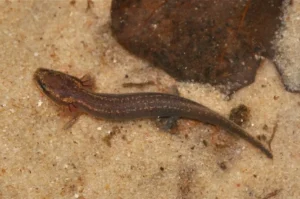
| Average Adult Size (Length) | 6 – 9 inches |
| Average Lifespan (Years) | 10 – 15 |
Western waterdogs were previously known as the “Gulf Coast waterdog“. They grow between 6 and 9 inches in length. Unlike sirens which only have front legs, waterdogs have 4 small well-developed legs (two forelegs and two hind legs).
They use these legs to slowly walk on the bottoms of streams or ponds. The legs can be flattened against the body to give them a more streamlined body during short swimming spurts. Each of their feet has four toes.
Western waterdogs have external gills that look like ostrich plumes on either side of their heads, just where their neck should have been.
Their coloration is generally dark brown but may appear much lighter due to multiple light brown and black speckles that join to form a net-like pattern. Large blackish-blue spots are scattered along the back and sides.
In Texas, these salamanders can be found in the Sabine River System.
Western Waterdog Range. Map By: United States Geological Survey.

18. Texas Blind Salamander (Eurycea Rathbuni)

| Average Adult Size (Length) | 3.5 – 5.5 inches |
| Average Lifespan (Years) | Unknown |
Texas blind salamanders grow between 3.5 and 5.5 inches in length. These salamanders are highly adapted to their life in underground water in dark caves; they have no eyes (their eyes are reduced to two black spots under their skin), and very little pigmentation on their body, making them pinkish-white in color.
They have a broad flattened head with a snout that is longer than most salamanders, long bright red external gills, a laterally compressed tail, and skinny legs to support their weight.
Texas blind salamanders are very rare and are only found in water-filled caves fed by the Edwards Aquifer in Hays County, Texas, where they depend on a constant supply of clean, cool water.
Texas Blind Salamander Range. Map By: United States Geological Survey.
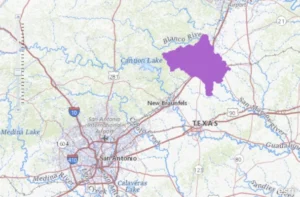
19. Austin Blind Salamander (Eurycea Waterlooensis)

Like the Texas blind salamander, Austin blind salamanders are highly adapted to their life in underground water in dark caves – and have no functional eyes, and very little pigmentation on their body, making them pinkish-white in color.
They have a broad flattened head with a long snout, long bright red external gills, a laterally compressed tail that makes up a large portion of their body, and elongated skinny legs.
Austin blind salamanders are only found in the dark, underground waters of the Edwards Aquifer that feed Barton Springs in Austin, Texas.
However, very little is known about these salamanders since their habitat is not easily accessed by humans
20. Barton Springs Salamander (Eurycea Sosorum)
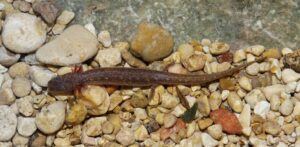
Barton springs salamanders are fairly small, reaching only about 2.5 inches in total length. They have highly variable – they can be dark gray, purplish-gray, gray-brown, or yellowish-brown. Regardless of their coloration, these salamanders usually have dark mottling on their back.
These salamanders have small narrow heads, red external gills, greatly reduced eyes, a laterally compressed tail, and 4 legs which they use to move around in their aquatic habitat.
As their name suggests, Barton springs salamanders are found only at outlets of Barton Springs in Zilker Park, Austin, Texas.
21. Georgetown Salamander (Eurycea Naufragia)

Like the Barton springs salamander, Georgetown salamanders are fairly small, only growing about 2 – 3 inches in total length
These salamanders have short, broad roughly shovel-shaped heads, which are widest at the point the upper and lower jaws meet.
They have relatively large eyes with gold-colored irises – a black line that runs from the corner of each eye to each nostril, and three red external gills on each side of their heads.
In terms of coloration, Georgetown salamanders are dark brown, dark olive, or gray – with juveniles being darker than adults. Many individuals also have a light, yellow stripe on the top of the tail. The underside is usually translucent.
Georgetown salamanders can be found in wet caves and springs in the San Gabriel River watershed in Williamson County, Texas, near Lake Georgetown. They have been observed at 14 locations in the county.
22. Jollyville Plateau Salamander (Eurycea Tonkawae)
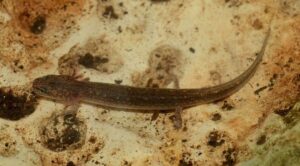
Jollyville Plateau salamanders (also known as Tonkawa Springs salamanders) typically grow about two inches in length.
These salamanders have well-developed eyes, broad heads with blunt snouts, external feathery gills protruding from either side of the head, and flat paddle-shaped tails.
Their coloration is dark greenish brown, and the underside is translucent.
Jollyville Plateau salamanders can be found in the Buttercup Cave system near Austin, Texas.
23. San Marcos Salamander (Eurycea Nana)
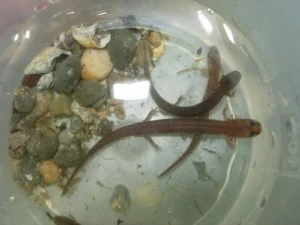
San Marcos salamanders typically measure about one to two inches in length. Like most other aquatic salamanders, they have external feathery gills attached to either side of their heads. Their coloration is a dark reddish brown.
San Marcos salamanders can be found only in Spring Lake and an adjacent downstream portion of the upper San Marcos River near Aquarena Springs, in Hays County, Texas
24. Salado Springs Salamander (Eurycea Chisholmensis)
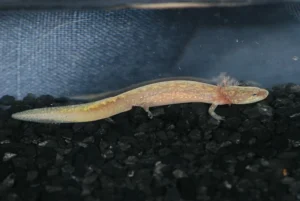
Salado Springs salamanders grow less than 3 inches in length. They have a dark reddish brown coloration, sometimes with yellowish irregularly shaped blotches on their back, head, legs, and sides. They have external feathery gills on either side of their head.
These salamanders are known in only two springs: Big Boiling Springs and Robertson Springs, near Salado, Texas.
25. Texas salamander (Eurycea neotenes)
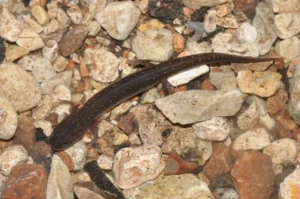
Texas salamanders (also known as Edwards Plateau salamanders, or Texas neotenic salamanders) grow between 2 and 4 inches in length.
These salamanders have a brown coloration often with yellow or brown mottling, with light-yellow spotting down the back. They have reduced eyes, bright-red external feathery gulls, and 4 short legs.
Texas salamanders are found only in Spring and cave systems in the Edwards Plateau region of central Texas, near Helotes, in Bexar County.
26. Valdina Farms Salamander (Eurycea Troglodytes)

Valdina Farms salamanders (sometimes called Valdina blind salamanders or sinkhole salamanders) grow about 2 to 3 inches in length. They have short legs, reduced eyes, and external feathery gills – and are typically gray or cream-colored, sometimes with pale yellow stripes or white specks.
These salamanders were once considered a subspecies of the Texas salamander but were declared a full species in the year 2000.
Valdina Farms salamanders were first described from Valdina Farms Sinkhole in Medina County, Texas, United States. However, they can also be found in springs and cave systems in the Bandera, Edwards, western Kerr, Real, and Uvalde counties.
27. Cascade Caverns Salamander (Eurycea Latitans)
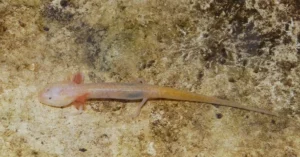
Cascade Caverns salamanders are small, only growing about 2 – 3 inches in length. These salamanders are very rarely seen, so not much is known about their coloration. However, in general, they have a translucent coloration, with a faint net-shaped pattern that is brown in color, often with white speckling.
They have stout bodies, with short legs, reduced eyes set under a layer of skin, and external feathery gills.
Cascade Caverns salamanders are found in the Cascade Caverns in Kendall County, Texas – and other cave systems nearby.
28. Blanco Blind Salamander (Eurycea Robusta)
Not much is known about Blanco blind salamanders. This species is known only from a single salamander, collected in the 1950s.
Four Blanco blind salamanders were discovered in 1951 by a gravel company digging in the dry bed of the Blanco river. Two were eaten by a heron, and one was lost. The remaining salamander was sent to the University of Texas at Austin for research.
They are only known to occur in a small region of the Blanco River near San Marcos in Hays County, Texas. However, since they live deep in limestone karst, scientists find it very difficult to collect specimens for research.
Still, these salamanders are believed to live in the Edwards Aquifer.
Frequently Asked Questions:
What salamanders live in North Texas? Salamanders that can be found in North Texas include; Eastern tiger salamanders, Barred tiger salamanders, Smallmouth salamanders, Spotted salamanders, and Eastern newts. Many of these salamanders are only found in Northeastern Texas, but some can also be found in North-central & Northwestern Texas.
What salamanders live in East Texas? Salamanders that can be found in East Texas include; Marbled salamanders, Eastern Tiger salamanders, Smallmouth salamanders, Spotted salamanders, Mole salamanders, Southern dusky salamanders, Spotted dusky salamanders, Dwarf salamanders, and Eastern Newts.
What salamanders live in South Texas? Salamanders that can be found in South Texas include; Barred tiger salamanders, Western slimy salamanders, black-spotted newts, and Rio Grande lesser sirens. Most of these salamanders only occur in one part of South Texas. For example, western slimy salamanders can only be found in South-Central Texas.
What salamanders live in West Texas? Western Texas is home to very few slamander species. Most salamanders in the state of Texas only occur in the eastern portion of the state. The Barred tiger salamander is one of the only few salamander species that can be found in west Texas.
What salamanders live in Central Texas? Slamander that be found in central Texas incude, the barred tiger salmander, the smallmouth salamander, and the western slimy salamander.
Conclusion
Texas is how several species of salamander, with some being more common their others
Many of Texas’s salamanders are terrestrial – which means they live on land, but there are also lots of fully aquatic species.
These fascinating amphibians are all over Texas, and you’re sure to catch sight of one if you take the time to look, especially in the springtime when they are most active.

